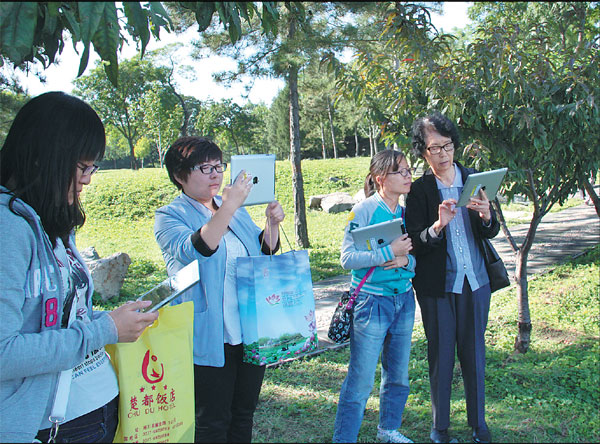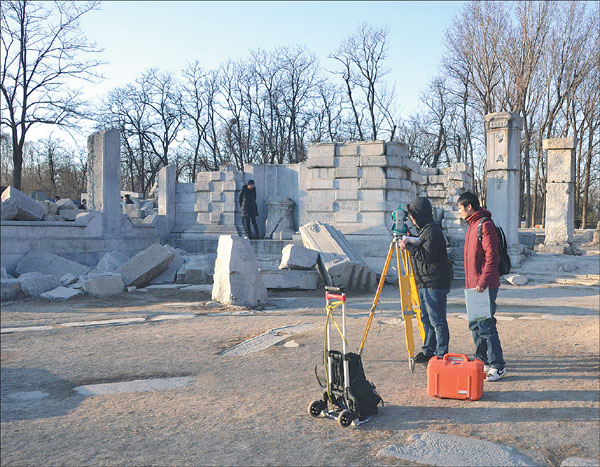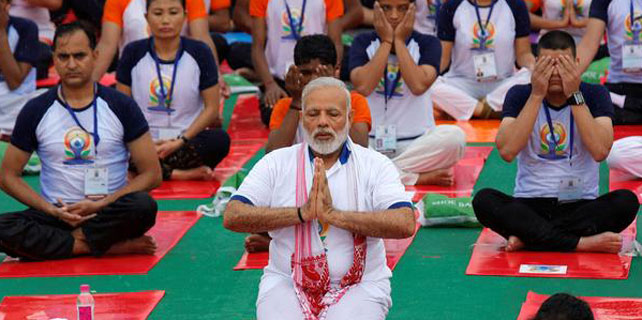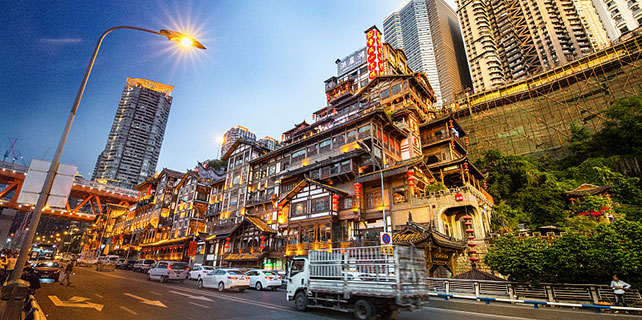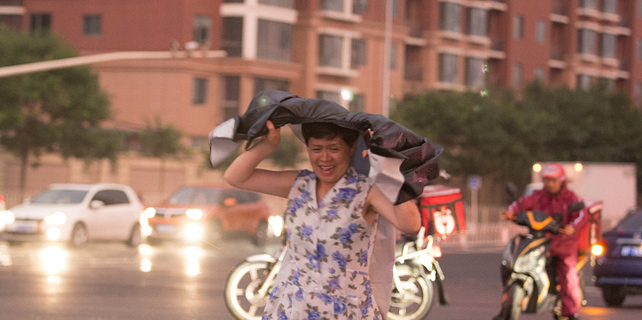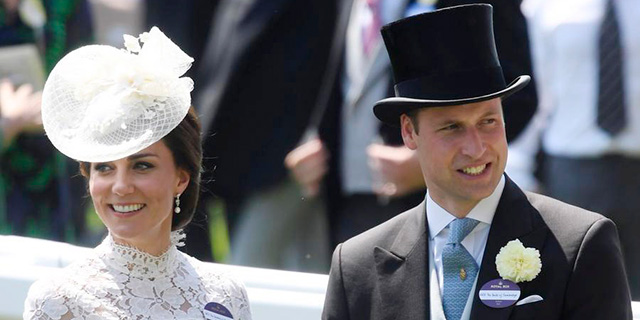Historic palace virtually rebuilt
Fifteen years ago, He Yan, an architecture student, was visiting the Old Summer Palace in Beijing with her academic supervisor, Guo Daiheng, of the School of Architecture at Tsinghua University.
Guo, 66, riding a bicycle through the park, pointed into the distance and told her 23-year-old protegee: "This is Jiuzhou Qingyan, and that is Tianran Tuhua, two palace complexes of the Old Summer Palace."
Anyone who had overheard the professor may well have thought she was hallucinating, for at that time the park was nothing but wasteland, and the buildings of which she spoke had been laid waste 142 years earlier.
|
Guo Daiheng (far right) of the School of Architecture at Tsinghua University. Photos Provided to China Daily |
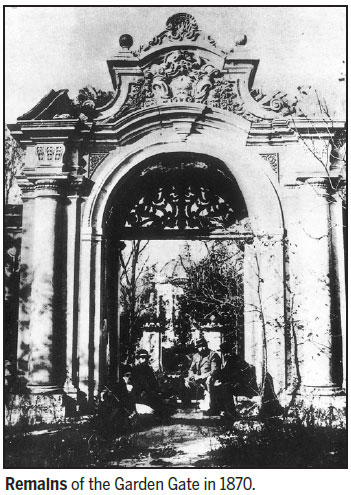
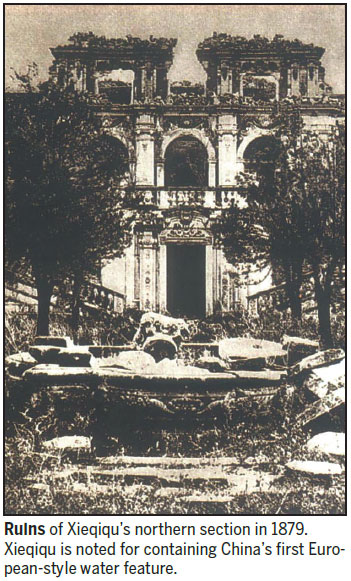
|
Surveyors map out the ruins of Xiyang Lou (Western Mansions). |
|
A digital restoration of a section of Xieqiqu (Harmonious Wonder). Provided to China Daily |
However, Guo's expertise in matters to do with the Old Summer Palace allowed her to effortlessly draw on her mind's eye to project exactly where the buildings had once stood.
The Emperor Kang Xi, the fourth emperor of the Qing Dynasty (1644-1911), started building the imperial park in 1709, and it was expanded by his two successors, Emperor Yong Zheng and Emperor QianLong. With constant construction over a century, the park eventually covered more than 3.33 square kilometers, the area of 600 soccer fields, and was home to more than 1,000 palaces and more than 100 viewing spots.
The Old Summer Palace, also known as Yuanmingyuan, designed and supervised by emperors themselves and built by the most talented and skilled workers, artisans and artists in ancient China, was the pinnacle of achievement in Chinese traditional parks, Guo says.
Its name is a little misleading, for emperors and their families did not just live there during summer. In fact, it was in the Old Summer Palace rather than the Forbidden City that emperors spent most of their time as they managed the country, met high-level officials and foreign ambassadors and celebrated festivals.
In the middle of the Qing Dynasty, Jiuzhou Qingyan was the residence of emperors, empresses and concubines. Tianran Tuhua, literally meaning a natural painting, one of the 40 top scenic spots in the Old Summer Palace, was renowned for its bamboo.
Though Guo has long been renowned for her expertise, He Yan was astonished at how the professor could envision in a field of weeds the splendid palaces that the allied army of Britain and France looted and burned down in 1860.
Now technology is making Guo's feat look rather simple. Anyone visiting the Old Summer Palace can see the original look of buildings on the screen of an iPad that can be rented in the park. It has an app installed that was developed by Beijing Re-Yuanmingyuan Co Ltd. He Yan is the director of the Tsinghua Heritage Institute for Digitalization.
Earlier this year Guo announced at Tsinghua University that her team had completed the research and development of a program called Digital Yuanmingyuan. More than 80 people spent 15 years on improving protection of the cultural heritage of the Old Summer Palace, drawing on more than 10,000 archives, completing 4,000 design drawings of the architecture, and making 2,000 digital models of the buildings.
Guo has been doing research on the palace for many years. In 1960 she graduated from Tsinghua University. Before her lay a career building houses, but she was instead assigned to teach and study ancient architecture and gardens at Tsinghua University.
She then started visiting and revisiting the Old Summer Palace. Farmers nearby had converted sections of it into farmland. In the overgrown weeds and farmland, Guo searched for the remnants of hills and water systems, bridges, artificial hills, stones, building foundations and stone carvings, which were scattered among houses, pigpens and woods and on the banks of rivers and lakes.
At the end of the 1980s Guo headed a team that was designing a tourist park based on the Old Summer Palace in Zhuhai, Guangdong province. She chose 18 of the 40 viewing places, which Emperor Qian Long's artists had painted in great detail, and rebuilt them in the 580,000-square-meter park.
It opened to the public during Spring Festival of 1997 and on March 8 that year, about 80,000 people visited it. But Guo always felt that the park could never be regarded as representing the cultural essence of the Old Summer Palace.
She was a frequent visitor to the National Library, where she would leaf through its many archives dedicated to the Old Summer Palace, and found a gold mine of interesting material. In 2000, she proposed an archive project relating to the palace and planned to set up a database about it, starting with material at the National Library.
Shortly before, the Beijing Administration of Cultural Heritage had started an archaeological dig on the wasteland of the palace site and invited Guo to formulate a study plan.
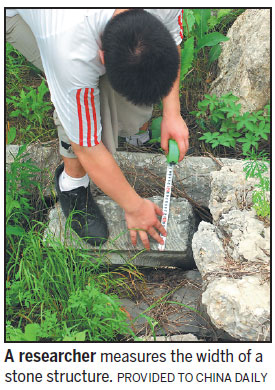
Guo then often rode a bicycle as she led students, among them He Yan, around the palace searching for sites among the ubiquitous weeds. They painstakingly looked for and found the remnants of roads in the undergrowth leading to many sites that few people had seen. They found the steps of the palace of Shangxia Tianguang, the caves and artificial hills of Xinghua Chunguan, and the location of the island in the middle of the lake of Tianran Tuhua.
In 2006 Hengdian World Studios, China's largest TV and film production center, in Zhejiang province, built a replica of the Old Summer Palace, unleashing a public debate on whether China should rebuild the palace on its original site, an idea that found solid support.
But Guo insisted that "we should have a clear recognition of the nature of the Old Summer Palace. Currently, it is an archaeological park, a bearer and transmitter of historical information. If we replace that bearer with new buildings, we cannot see the original things".
Guo is an advocate of the ideas of her teacher Liang Sicheng on protecting cultural relics and historical sites. This approach puts a premium on protective measures that manage changes over the years and help buildings survive by bringing them into a proper state of repair rather than turning old buildings into ones as new as the original ones were when they were built.
It is impossible today to make many things that would have been integral to the Old Summer Palace because the materials, tools and methods people used 150 years ago were vastly different from what people use now, Gou says.
For example, Hanjingtang, which Emperor Qianlong built for his retirement, was constructed using the finest techniques and earth that was rammed layer by layer, she says. If it was rebuilt today, people would simply use concrete, with the attendant loss of historical integrity, she says.
In addition, emperors were able to call on the services of the best artists, artisans and workers around the country to build the palaces, something that cannot be replicated today, she says.
In 2009, Guo's team, comprising specialists in archaeology, history, architecture, gardens, 3D modeling, virtual reality technology, databases, visual arts and internet engineering, started using digital technology to bring the Old Summer Palace back to life, thus allowing contemporary audiences to appreciate its splendor.
A mountain of information is needed to make the rendering of scenic spots realistic, especially in showing the details of the buildings. There are more than 10 steps to digitally reconstructing each scenic spot.
Based on laborious studies by Guo and her students of the Old Summer Palace and maps drawn up in 1933, 1965 and 2002, the team became aware of how hills and water systems had changed over the years, making it easier to collect and collate information on the sites.
Referring to design drawings from when the park was built, paintings and calligraphy works created at that time, and other archives and material, the team analyzed the characteristics of each building and the spatial aspects of the scenic spots and determined the characteristics of special buildings, such as how to arrange artificial hills, flowers and plants.
Researchers then attempted to draw up a plan of each scenic spot and design the buildings, furnishings, decorations and gardens based on the information they got, and then build the 3-D scenes.
However, historical archives and other material are far from a complete repository of the information needed.
"Because we are doing rigorous scientific research, we use different colors to mark the sources we refer to," He says,
"The red parts, 15 percent of the total, are built based on remnants at the site," she says, showing an illustration of accuracy analysis. "The green parts, 30 percent of the total, are based on replicating objects, the blue ones are based on photographs, which is about 40 percent, and the other 15 percent are imaginative, based on copperplate etchings.
"We will continue to make this more precise with updated information."
As He Yan showed the Shangxia Tianguang scenic spot, she seemed as proud as an old emperor showing visitors around his place. Based on historical information obtained, six different models were created.
During the Yongzheng period and the early Qianlong period, it was unsymmetrical and the house on one side extended to the lake, but in the middle of the Qian Long period pavilions were located symmetrically on each side. Other changes occurred too, according to the aesthetic tastes of different emperors.
Guo says her team has completed the accurate digital restoration of 60 percent of the area of the park. The plan is for its tremendous work to be presented in different ways, including virtual reality and a mixed reality show.
It will encourage people to visit the Old Summer Palace and be a guide for them when they are there, she says, and will be useful in education, making films and creating video games.
"We hope that as our scientific research is put to the service of the public, many more people will be able to enjoy the charm of the Old Summer Palace."
yangyangs@chinadaily.com.cn
(China Daily European Weekly 06/23/2017 page1)



